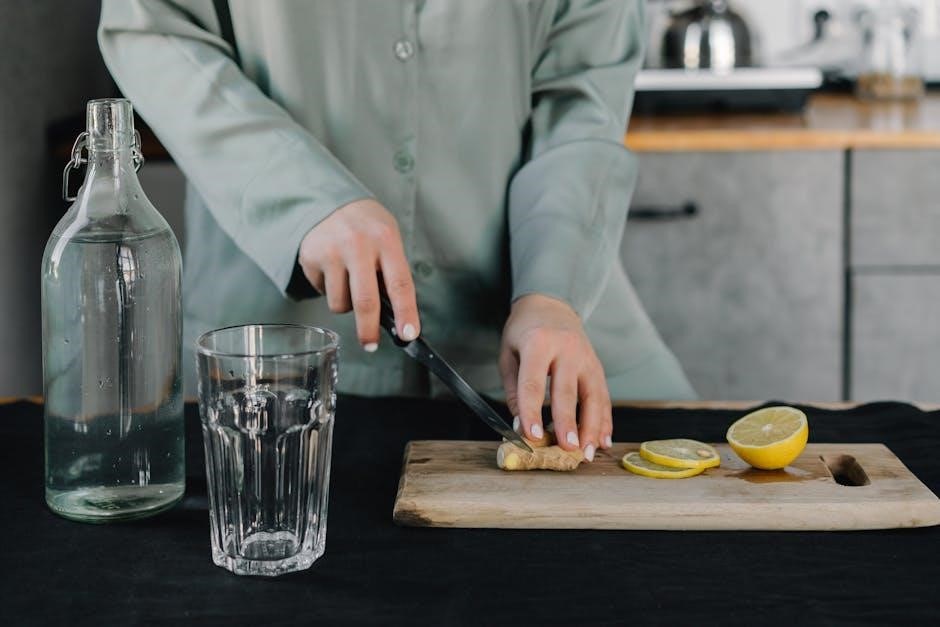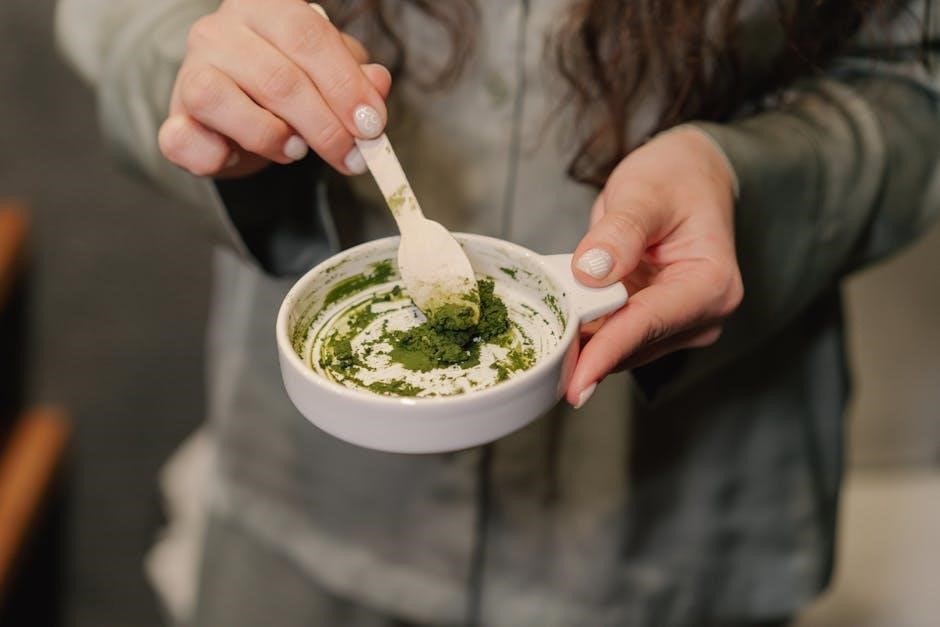Molarity practice problems are essential for mastering chemical concentration calculations. These exercises help students understand how to prepare solutions‚ calculate solute amounts‚ and determine concentrations accurately. Regular practice improves problem-solving skills and enhances understanding of stoichiometry principles. This section provides a comprehensive overview of various molarity-related problems‚ offering clear guidance and answers to common challenges faced in chemistry labs and classrooms.
What is Molarity?
Molarity (M) is a measure of solute concentration in a solution‚ defined as the number of moles of solute per liter of solution. It is a critical concept in chemistry for preparing and analyzing solutions. The formula for calculating molarity is:
M = moles of solute / liters of solution
Molarity is essential for determining the amount of substance needed to prepare a solution and for understanding chemical reactions. It is widely used in laboratories‚ research‚ and industrial applications to ensure accurate and reproducible results. Mastering molarity calculations is a foundational skill for chemists and students alike.
Why Practice Molarity Problems?
Practicing molarity problems is crucial for developing problem-solving skills in chemistry. It helps students understand how to calculate concentrations‚ prepare solutions‚ and apply stoichiometric principles. Regular practice builds confidence and improves accuracy in laboratory settings. Molarity problems also enhance critical thinking and the ability to interpret data. By solving various types of problems‚ students gain a deeper understanding of chemical concepts and develop essential skills for advanced studies and real-world applications in science and engineering.
Overview of Common Molarity Calculations
Molarity calculations involve determining concentrations‚ volumes‚ or amounts of solutes in solutions. Common tasks include converting grams to moles using molar mass‚ calculating solution volumes‚ and determining concentrations. Dilution problems require understanding concentration changes when solutions are mixed or diluted. Additionally‚ calculations involve finding molarity from moles or mass and determining final concentrations in mixed solutions. These exercises help students master stoichiometric relationships and apply them to real-world scenarios‚ ensuring accuracy in laboratory and industrial settings. Regular practice enhances problem-solving efficiency and conceptual understanding.

Types of Molarity Practice Problems
Molarity problems involve calculating grams of solute needed‚ volume of solution required‚ molarity from moles or mass‚ dilution effects‚ and final concentrations in mixed solutions.
Calculating Grams of Solute Needed
To determine the grams of solute required for a solution‚ use the formula:
[ ext{Grams of Solute} = ext{Molarity} imes ext{Volume (L)} imes ext{Molar Mass} ]
For example‚ to prepare 200 mL of a 2.5 M potassium carbonate solution‚ calculate moles needed (2;5 M * 0.2 L = 0.5 mol)‚ then multiply by the molar mass (138.21 g/mol) to get 69.1 grams. This method ensures accurate preparation of solutions in lab settings‚ essential for maintaining precise chemical concentrations.
Calculating Volume of Solution Needed
To find the volume of solution required‚ rearrange the molarity formula:
[ ext{Volume (L)} = ext{Moles of Solute} / ( ext{Molarity} imes ext{Molar Mass} ) ]
For instance‚ to prepare 4 M lithium bromide solution using 100 grams‚ calculate moles (100 g / 86.849 g/mol ≈ 1.152 mol)‚ then divide by molarity (4 M) to get 0.288 liters. This method helps in determining the exact volume needed for precise chemical solutions‚ ensuring accuracy in laboratory and experimental setups.
Calculating Molarity from Moles
Calculating molarity from moles involves dividing the number of moles of solute by the volume of the solution in liters. For example‚ a 0.30 L solution with 0.50 moles of NaCl yields a molarity of 1;7 M. This method is straightforward when moles are known‚ ensuring accurate concentration determination. Always convert volume to liters and use precise mole values for reliable results. This approach is fundamental in chemistry for preparing and analyzing solutions effectively.
Calculating Molarity from Mass
Calculating molarity from mass requires converting grams of solute to moles using the molar mass‚ then dividing by the solution’s volume in liters. For example‚ to find the molarity of a solution with 14.2 g of NaNO3 (molar mass 85.0 g/mol) in 350 mL‚ first calculate moles: 14.2 g / 85.0 g/mol = 0.167 moles; Then‚ divide by volume in liters: 0.167 mol / 0.350 L ≈ 0.477 M. Ensure accurate unit conversions and significant figure handling for precise results. This method is crucial for preparing solutions with specific concentrations in chemistry experiments and analyses.
Dilution Problems
Dilution problems involve adjusting solution concentrations by changing the volume of solvent. The formula M1V1 = M2V2 is central‚ where M is molarity and V is volume. For example‚ diluting 100 mL of 2 M solution to 0.5 M requires adding water to reach 400 mL. Mixing solutions of different concentrations‚ like 200 mL of 3 M HCl with 300 mL of 1 M HCl‚ results in a final concentration of 1.8 M. When using concentrated solutions to make diluted ones‚ such as 12 M H2SO4 to make 2 L of 0.5 M‚ calculate the needed volume as ~83.3 mL. Serial dilutions and precise measurements with volumetric flasks are crucial for accuracy. Contamination prevention and understanding practical lab considerations are also key.
Concentration of Solutions
Determining the concentration of solutions is a fundamental aspect of molarity practice. Problems often involve calculating molarity using the formula M = moles/solume. For instance‚ dissolving 14.2 g of NaNO3 (molar mass 85.0 g/mol) in 350 mL of solution yields a molarity of 0.41 M. Similarly‚ mixing solutions‚ such as 60 mL of 0.5 M NaOH with 140 mL of 0.3 M NaOH‚ requires calculating the final concentration (0.38 M). These exercises emphasize precise calculations and understanding of solute distribution in solutions‚ essential for lab applications and chemical analysis.
Mixed Solutions and Final Molarity
Mixed solutions involve combining two or more solutions to achieve a final molarity. For example‚ mixing 60 mL of 0.5 M NaOH with 140 mL of 0.3 M NaOH results in a final molarity of 0.38 M. To calculate this‚ determine the moles of solute in each solution‚ add them‚ and divide by the total volume. This concept is crucial for understanding how concentrations change when solutions are combined‚ ensuring accurate results in lab settings and chemical analyses. Regular practice helps refine these calculations and build confidence in handling mixed solution problems.

Specific Molarity Practice Problems with Answers
How many grams of sodium chloride are needed to make 500 mL of a 1.2 M solution? Molar mass of NaCl is 58.44 g/mol. Answer: 34.86 grams.
Problem 1: Potassium Carbonate Solution
How many grams of potassium carbonate (K₂CO₃) are needed to prepare 200 mL of a 2.5 M solution? The molar mass of K₂CO₃ is 138.21 g/mol.
Formula: moles = Molarity × Volume (L)
Calculation: 2.5 mol/L × 0.2 L = 0.5 mol
Mass: 0.5 mol × 138.21 g/mol = 69.1 g
Answer: 69.1 grams of potassium carbonate are required.
Problem 2: Lithium Bromide Solution
How many liters of a 4.0 M lithium bromide (LiBr) solution can be prepared using 100 grams of LiBr? The molar mass of LiBr is 86.85 g/mol.
Formula: Molarity = moles / volume → volume = moles / Molarity
Calculation:
Moles of LiBr = 100 g / 86.85 g/mol ≈ 1.15 mol
Volume = 1.15 mol / 4.0 M = 0.29 L
Answer: 0.29 liters of a 4.0 M lithium bromide solution can be made.
Problem 3: Sodium Hydroxide Solution
A chemistry student mixes 60 mL of a 0.5 M NaOH solution with 140 mL of a 0.3 M NaOH solution. What is the molarity of the resulting solution?
Formula: Molarity = total moles / total volume
Calculation:
Moles from 0.5 M solution = 0.060 L × 0.5 mol/L = 0.030 mol
Moles from 0.3 M solution = 0.140 L × 0.3 mol/L = 0.042 mol
Total moles = 0.030 + 0.042 = 0.072 mol
Total volume = 60 mL + 140 mL = 200 mL = 0.200 L
Molarity = 0.072 mol / 0.200 L = 0.36 M
Answer: The molarity of the resulting sodium hydroxide solution is 0.36 M.

Problem 4: Sodium Chloride Solution
What is the molarity of a 0.30-liter solution containing 0.50 moles of NaCl?
Formula: Molarity (M) = moles of solute (mol) / liters of solution (L)
Calculation:
- Moles of NaCl = 0.50 mol
- Volume of solution = 0.30 L
- Molarity = 0.50 mol / 0.30 L = 1.67 M
Answer: The molarity of the sodium chloride solution is 1.67 M.
Problem 5: Copper (II) Fluoride Solution
How many grams of copper (II) fluoride are needed to prepare 6.7 liters of a 1.2 M solution?
Given:
- Molarity (M) = 1.2 M
- Volume (V) = 6.7 L
- Molar mass of CuF₂ = 87.55 g/mol
Formula: moles = M × V
Calculation: moles = 1.2 mol/L × 6.7 L = 8.04 mol
Mass: 8.04 mol × 87.55 g/mol = 704.47 g
Answer: 704.47 grams of copper (II) fluoride are required.
Problem 6: Ammonium Sulfite Solution
What is the concentration of a solution with a volume of 3.3 mL that contains 12 grams of ammonium sulfite?
Given:
- Mass of solute = 12 g
- Volume of solution = 3.3 mL = 0.0033 L
- Molar mass of (NH₄)₂SO₃ = 116.14 g/mol
Formula: Molarity (M) = moles / volume
Calculation: Moles = 12 g / 116.14 g/mol = 0.1033 mol
M = 0.1033 mol / 0.0033 L ≈ 31.33 M
Answer: The concentration of the solution is approximately 31.33 M.
Problem 7: Sodium Nitrate Solution
What is the molarity of a solution prepared by dissolving 14.2 g of NaNO₃ (molar mass 84.99 g/mol) in enough water to make 350 mL of solution?
Given:
- Mass of NaNO₃ = 14.2 g
- Molar mass of NaNO₃ = 84.99 g/mol
- Volume of solution = 350 mL = 0.350 L
Formula: Molarity (M) = moles / volume
Calculation: Moles = 14.2 g / 84.99 g/mol ≈ 0.167 mol
M = 0.167 mol / 0.350 L ≈ 0.477 M
Answer: The molarity of the sodium nitrate solution is approximately 0.477 M.
Problem 8: Hydrochloric Acid Solution
What is the molarity of a solution containing 5.5 g of HCl (molar mass 36.46 g/mol) dissolved in enough water to make 250 mL of solution?
Given:
- Mass of HCl = 5.5 g
- Molar mass of HCl = 36.46 g/mol
- Volume of solution = 250 mL = 0.250 L
Formula: Molarity (M) = moles / volume
Calculation: Moles = 5.5 g / 36.46 g/mol ≈ 0.151 mol
M = 0.151 mol / 0.250 L ≈ 0.604 M
Answer: The molarity of the hydrochloric acid solution is approximately 0.604 M.
Problem 9: Iron (II) Chloride Solution
What is the molarity of a solution containing 200 grams of iron (II) chloride (FeCl₂) dissolved in 450 mL of solution? The molar mass of FeCl₂ is 162.2 g/mol.
Given:
- Mass of FeCl₂ = 200 g
- Molar mass of FeCl₂ = 162.2 g/mol
- Volume of solution = 450 mL = 0.450 L
Formula: Molarity (M) = moles / volume
Calculation: Moles = 200 g / 162;2 g/mol ≈ 1.234 mol
M = 1.234 mol / 0.450 L ≈ 2.743 M
Answer: The molarity of the iron (II) chloride solution is approximately 2.743 M.
Problem 10: Copper Carbonate Solution
What is the molarity of a solution prepared by dissolving 14;2 g of copper carbonate (CuCO₃) in enough water to make 350 mL of solution? The molar mass of CuCO₃ is 123.55 g/mol.
Given:
- Mass of CuCO₃ = 14.2 g
- Molar mass of CuCO₃ = 123.55 g/mol
- Volume of solution = 350 mL = 0.350 L
Formula: Molarity (M) = moles / volume
Calculation: Moles = 14.2 g / 123.55 g/mol ≈ 0.1148 mol
M = 0.1148 mol / 0.350 L ≈ 0.328 M
Answer: The molarity of the copper carbonate solution is approximately 0.328 M.

Stoichiometry and Molarity
Stoichiometry is fundamental to molarity calculations‚ linking molar masses‚ moles‚ and solution volumes. Accurate conversions ensure precise determination of solute concentrations in chemical solutions.
Using Molar Mass in Calculations
Molar mass is crucial in converting grams of solute to moles‚ essential for molarity calculations. By dividing the mass by the molar mass‚ the number of moles is found. This step is vital for determining the concentration of solutions accurately. Common errors include incorrect use of molar masses or forgetting to convert grams to moles. Practice problems often involve substances like potassium carbonate or sodium chloride‚ where precise molar mass values ensure accurate results. This fundamental skill is key to mastering molarity and stoichiometry in chemistry.
Converting Grams to Moles
Converting grams to moles is a critical step in molarity calculations. This involves dividing the mass of the solute by its molar mass. For example‚ to find moles of NaCl‚ divide the grams by 58.44 g/mol. Common errors include using incorrect molar masses or forgetting to convert units. Practice problems often require this conversion for substances like K2CO3 or LiBr‚ ensuring accuracy in determining solution concentrations. Regular practice helps build proficiency in this essential skill‚ which is fundamental for solving molarity and stoichiometry problems effectively in chemistry.
Converting Moles to Molarity
Converting moles to molarity involves dividing the number of moles of solute by the volume of the solution in liters. For instance‚ if a solution contains 0.50 moles of NaCl in 0.30 liters‚ the molarity is 1.7 M. Common challenges include unit conversions and ensuring volumes are in liters. Practice problems‚ such as calculating the molarity of solutions with varying solute amounts‚ help reinforce this concept. Accurate calculations are crucial for determining solution concentrations‚ making this a foundational skill in chemistry and laboratory settings.

Dilution and Concentration Problems
Dilution and concentration problems involve calculating final concentrations after mixing solutions. Key formulas and precise volume measurements are essential for accurate results in these calculations.
Calculating Final Concentration
Calculating final concentration is a fundamental skill in molarity practice problems. It involves understanding dilution principles and applying formulas like M1V1 = M2V2. Students must accurately measure volumes and convert units to ensure precise calculations. Common scenarios include mixing solutions of different concentrations or diluting a stock solution. Practice problems often require determining the molarity of the resulting solution after mixing or dilution. Mastering these calculations is essential for chemistry lab work and real-world applications. Regular practice helps build confidence and improves problem-solving efficiency in handling complex molarity-related challenges.
Volume and Molarity Relationships
Volume and molarity are intricately linked in chemistry‚ particularly in dilution and concentration calculations. The formula M1V1 = M2V2 is widely used to determine the volume or molarity of solutions before and after dilution. Understanding this relationship is crucial for accurately preparing solutions in lab settings. Practice problems often involve finding the volume of a stock solution needed to achieve a specific molarity in a larger volume of diluted solution. Regular practice helps students grasp how concentration changes with volume‚ ensuring precise calculations and avoiding errors in experimental setups. This skill is vital for chemists when preparing solutions for various analyses and reactions.

Mixed Solutions and Final Molarity
Mixed solutions involve combining two or more solutions to achieve a final molarity. Calculating the total moles and redistributing them in the combined volume ensures accuracy in determining the final concentration.
Mixing Two Solutions of the Same Solute
Mixing two solutions of the same solute requires calculating the total moles from both solutions. The final molarity is determined by adding the moles and dividing by the total volume; For example‚ mixing 60 mL of 0.5 M NaOH with 140 mL of 0.3 M NaOH results in a final molarity of 0.44 M. This involves summing the moles from each solution and dividing by the combined volume‚ ensuring precise calculation of the resulting concentration.
Calculating Final Volume and Molarity
Calculating final volume and molarity involves determining the total moles of solute and the total solution volume after mixing. For example‚ mixing 60 mL of 0.5 M NaOH with 140 mL of 0.3 M NaOH results in a total volume of 200 mL. The moles of NaOH from each solution are calculated separately and summed. Using the formula M₁V₁ + M₂V₂ = M_total × V_total‚ the final molarity is found to be 0.44 M. This method ensures accurate determination of both the final concentration and volume of the combined solution‚ essential for precise chemical preparations.

Common Mistakes and Tips
- Avoid unit conversion errors by ensuring all measurements are in liters and grams.
- Always use significant figures appropriately for precise calculations.
- Double-check the molarity formula: M = moles/solume.
- Understand the difference between grams of solute and solution volume.
- Practice regularly to master stoichiometric relationships in solutions.
Unit Conversion Errors
Unit conversion errors are common in molarity calculations‚ often leading to incorrect results. Students frequently misuse milliliters (mL) instead of liters (L) or grams instead of moles. For instance‚ failing to convert solution volumes from mL to L can significantly affect molarity values. Similarly‚ miscalculating molar masses or misapplying conversion factors can compound errors. To avoid these mistakes‚ always ensure units align with the molarity formula (M = moles/solume) and double-check conversions. Proper attention to units is critical for accurate solutions in chemistry problems.
Significant Figures in Molarity
Significant figures are crucial in molarity calculations to ensure precision and accuracy. Errors often arise when students fail to consider the number of significant figures in given values. For example‚ if a solution volume is measured as 250 mL (three significant figures)‚ the final molarity should also be reported with three significant figures. Ignoring this rule can lead to misleading results. Always apply significant figure rules consistently throughout calculations to maintain the integrity of your answers. This practice reinforces the importance of precision in scientific measurements and reporting. Proper handling of significant figures is essential for reliable molarity determinations.
Understanding the Formula
Understanding the molarity formula is foundational for solving practice problems. Molarity (M) is defined as the number of moles of solute (n) divided by the volume of solution (V) in liters: M = n/V. Accurately calculating moles requires knowing the molar mass of the solute and correctly converting grams to moles. Common errors include misapplying units or miscalculating molar masses. Mastery of this formula is essential for determining concentrations‚ preparing solutions‚ and solving dilution problems. Consistent practice helps build fluency in applying the formula to various scenarios‚ ensuring accurate and reliable results in chemistry calculations.
Mastering molarity practice problems enhances chemical understanding and problem-solving skills. Consistent practice and attention to detail ensure accuracy in calculations and solution preparation‚ fostering confidence in chemistry concepts.
Molarity‚ defined as moles of solute per liter of solution‚ is crucial for chemical calculations. Key concepts include calculating moles from grams using molar mass‚ converting between grams and moles‚ and understanding dilution principles. Common problems involve determining solute mass for a desired molarity‚ calculating solution volume‚ and finding molarity from moles or mass. Dilution problems use the formula ( M_1V_1 = M_2V_2 ). Mixing solutions requires understanding final molarity and volume. Unit conversion and significant figures are critical for accuracy. These concepts form the foundation for solving molarity problems effectively‚ ensuring precision in chemical preparations and analyses.
Encouragement for Further Practice
Consistent practice is key to mastering molarity calculations. Regularly solving problems enhances understanding of stoichiometry‚ concentration‚ and dilution principles. Start with basic problems like calculating grams of solute or volume of solution‚ then progress to more complex scenarios involving mixed solutions or final concentrations. Use online resources or PDF guides for structured exercises and answers. Each problem solved builds confidence and improves accuracy. Dedicate time daily to practice‚ focusing on unit conversions and significant figures. With persistence‚ you’ll excel in molarity calculations and gain a strong foundation in chemistry.

References and Resources
Access molarity practice problems with answers via PDF resources and online tools. These materials provide comprehensive exercises and solutions‚ ideal for self-study and skill improvement in chemistry.
Recommended PDF Resources
Several PDF resources offer comprehensive molarity practice problems with detailed solutions. Websites like Coursera‚ Khan Academy‚ and educational forums provide downloadable PDFs. These documents include step-by-step guidance for problems such as calculating grams of solute‚ volume of solution‚ and molarity from moles or mass. They also cover dilution problems and mixed solutions. Many PDFs are designed for chemistry students‚ offering clear explanations and example problems. These resources are ideal for self-study and skill improvement‚ ensuring a thorough understanding of molarity concepts and calculations.
Online Tools for Molarity Practice

Online tools like molarity calculators and interactive simulations are invaluable for practicing molarity problems. Websites such as Khan Academy‚ ChemCollector‚ and online chemistry labs offer interactive exercises and quizzes. These tools provide real-time feedback‚ helping students identify errors and improve their problem-solving skills. Some platforms include step-by-step solutions and video tutorials‚ while others allow users to input their own problems for practice. These resources are accessible anytime‚ making them ideal for self-paced learning and reinforcing concepts learned in the classroom or through PDF materials.
